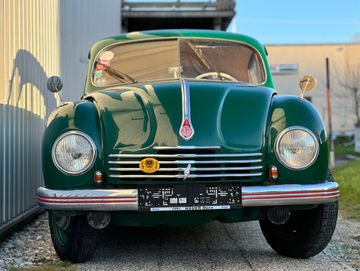Tatra 600 'Tatraplan'
FACTS
1952
1948 - 1952
CONSTRUCTION YEAR
Boxer Air-Cooled
4 cylinders
1,952 CCM
52 hp
ENGINE
Hans Ledwinka
DESIGNERS
6,432
NUMBER OF PIECES

STORY
The Tatra 600 "Tatraplan" is a true milestone in automotive history and embodies the technical genius of the designer Hans Ledwinka, who together with his team created an icon of automotive engineering. The Tatraplan, built from 1948 to 1952, relies on a number of groundbreaking design principles that impressively demonstrate Ledwinka's innovative spirit and technical skill.
One of the outstanding features of the Tatra 600 is its air-cooled rear engine, a concept that Ledwinka developed with great care. The air-cooled four-cylinder boxer engine with a displacement of 1,952 cc and an output of around 52 hp offered remarkable efficiency and reliability in the 1940s and 50s. Thanks to air cooling, complex cooling systems were dispensed with, which made the vehicle less maintenance-intensive and at the same time increased the robustness of the engine.
Ledwinka and his team also focused on aerodynamics during development: the Tatraplan is characterized by a flowing, streamlined body that ensures optimal air circulation and reduces fuel consumption. This design was visionary at the time and underlines Ledwinka's pioneering spirit, which had a lasting influence on the automotive industry.
The Tatra 600 Tatraplan is an outstanding example of the innovative power of the Tatra brand and its chief engineer Hans Ledwinka. Visit us at *Manro Classic* and discover the impressive heritage and technical sophistication of this classic automobile.
PERSONAL STORY
The Tatra Plan was delivered by the renowned company TARBUK in Vienna and found its first home at a weaving mill in Lower Austria, a region that was considered a stronghold of the textile industry at the time.
Serving in the midst of a thriving weaving culture, this elegant carriage combined modern technology with the traditional craftsmanship of the region, which was known worldwide for its high-quality fabrics.








